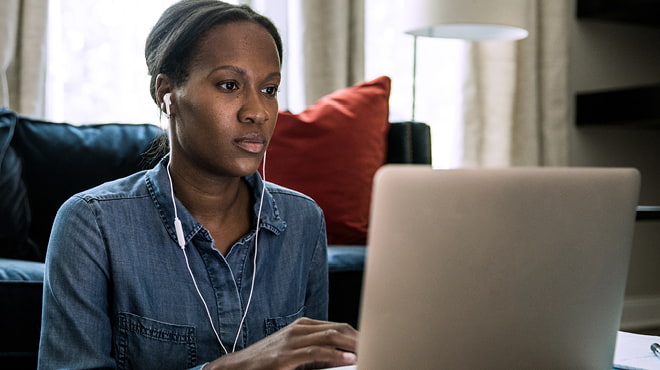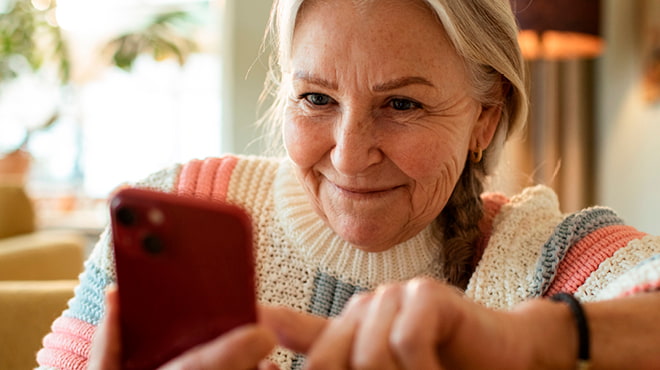Recent Posts
-
 Patient StoriesA lifesaver saved: An EMS veteran’s journey from rescue to recoveryNovember 14, 2025
Patient StoriesA lifesaver saved: An EMS veteran’s journey from rescue to recoveryNovember 14, 2025 -

-

Monitoring COVID-19 using virtual technology

At first, Carla Fast thought she was experiencing a seasonal sinus attack. She had a sore throat and a low fever. The 59-year-old Fairmont, Minnesota, teacher had been following the necessary safety and cleaning precautions in her classroom. Yet she knew she was coming down with something on a Tuesday afternoon in September.
Later that evening, her symptoms worsened and her fever rose, so she went to the Emergency Department at Mayo Clinic Health System in Fairmont to be evaluated. Carla was tested for COVID-19 and sent home. The following day, her result was positive, and she was contacted by Mayo Clinic's COVID-19 team.
Due to increased health risk, she was started on the Remote Patient Monitoring program. This program uses medical technology and monitors to screen patients' vital signs and symptoms every day.
Carla received the kit because she was considered at a higher risk for COVID-19 complications due to prior experiences with cold-induced asthma.
Remote patient monitoring kits include a blood pressure cuff, thermometer, pulse oximeter and a weight scale. Patients like Carla use these devices two to four times a day to measure their vital signs.
These measurements are sent automatically to Mayo Clinic through a cellular-enabled tablet that patients receive with their kits. Remote Patient Monitoring program nurses also call patients to determine if they are experiencing symptoms, such as nausea and shortness of breath.
"I was pretty much OK, and it wasn't too bad until Saturday morning," says Carla. "I entered my information on the tablet that morning and noticed I was pretty tired. About three minutes later, the phone rang and it was the monitoring team."
The team had noticed that Carla's oxygen level was low and asked her to put the pulse oximeter back on her finger to gather another reading. Both times, her oxygen level was 83.
"I didn't realize that was low," says Carla. "They told me that they wanted me to go to the hospital. By the time I got upstairs to tell my husband, I was falling down because I was so tired."
Carla's husband brought her to the Emergency Department at Mayo Clinic Health System in Fairmont, where she was evaluated and soon admitted to the hospital.
"Carla presented to the Emergency Department in respiratory failure with low oxygen levels. We were concerned with Carla's low oxygen level and severe fatigue," says Dr. Andrew Brevik, D.O., a Mayo Clinic Health System hospitalist. "It was important to monitor her closely because she has a history of asthma. In addition, there are specific treatment options available early in the disease prognosis, so the best option for Carla was to admit her to the hospital."
Carla spent five days in the Fairmont hospital. Her treatment plan included supplemental oxygen; dexamethasone, a steroid; and remdesivir, an antiviral medication. During this time, visitors were not allowed, so she talked and prayed with her husband every day on the phone.
"I was so impressed with the team at the hospital," says Carla. "The doctors and nurses were just amazing. I still pray for them by name every day."
"Carla improved dramatically over the next several days and no longer required supplemental oxygen," says Dr. Brevik. "We were able to discharge her to home after the standard five-day treatment.
Carla returned home under the care of her husband. She had the remote patient monitoring kit at home when she developed a low fever three days later.
"I pushed the button [on the tablet] to call the nurses," she says. "They had me track a few things and then connected with me Dr. Morris."
Marie Morris, M.D., is a Family Medicine physician at Mayo Clinic Health System in Fairmont and Carla's primary care provider.
"Carla's fever was concerning, and we wanted to figure out what was going on so she could avoid another hospital stay. Thankfully, she had the virtual technology in her home so we could track her vitals," says Dr. Morris. "After reviewing her vitals and medical record, it appeared that she may have developed bacterial pneumonia on top of COVID-19. I was able to prescribe her medications to treat it while still at home."
Their virtual connections didn't end there.
Two days later, Carla and Dr. Morris virtually connected during a video appointment to check on her recovery. Video appointments are similar to face-to-face appointments. However, patients connect to providers through a secure video rather than going to the clinic.
"Video appointments are a safe and convenient way to connect with patients that allows them to remain in the comfort of their homes. This was important for Carla, as she was still recovering from COVID-19," says Dr. Morris. "Before the COVID-19 pandemic, Mayo Clinic was developing online access to care and telehealth tools for patients to manage their health from home. This option lets patients continue to receive the care they need, while helping practice social distancing during the pandemic."
Carla had another video appointment with Dr. Morris a few weeks later to assess her ongoing progress.
"Carla is recovering well from the virus, but continues to struggle with lingering symptoms of fatigue and brain fog. Unfortunately, this is common for patients who have had COVID-19," says Dr. Morris. "I've had the privilege of knowing Carla for many years, and she is compassionate, intelligent and dedicated to education, whether in the classroom or telling others about her journey with COVID."
Carla recognizes that her recovery will take time, but is grateful to the expert health care available in her hometown.
"I'm just so thankful and grateful to God for sending me to Mayo," she says. "People don't realize the treasures we have here in Fairmont. They saved my life, and it's just fantastic."



